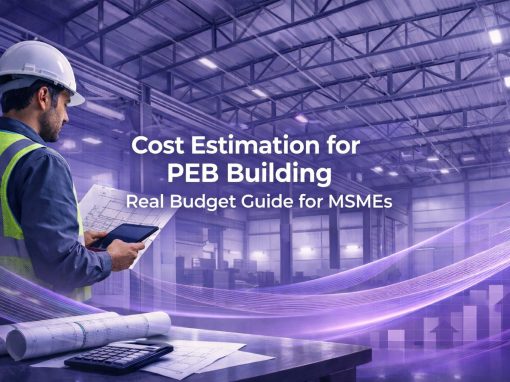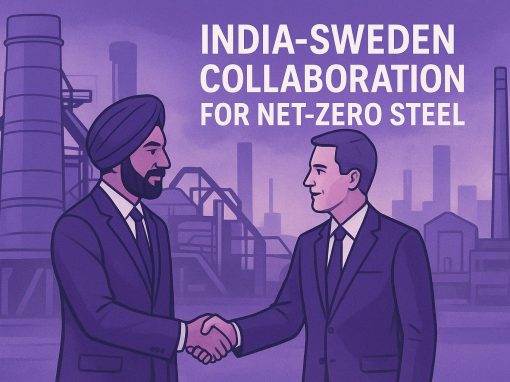Table of Contents
Tata Steel Ltd, India’s second-largest steel producer by market capitalisation, announced its Q2 results on 12 November 2025, for the quarter ended 30 September 2025. The company reported a consolidated net profit (PAT) of ₹3,102 crore, up nearly 272% year-on-year, while revenue rose around 9% to ₹58,689 crore.
These results confirmed analysts’ earlier expectations of a strong rebound, driven by lower coking coal costs, higher volumes, and improved operational efficiency.
This performance matters beyond the stock market. For MSMEs and steel buyers across India, including fabricators, construction firms, and component manufacturers. Tata Steel’s results signal potential relief on raw-material pricing. Falling input costs and steady output can ease procurement pressure and improve cost visibility across the steel value chain.
Market Context: Snapshot of Steel Sector Before Q2
Stronger domestic demand after monsoon
India’s finished steel production and consumption showed healthy growth through mid 2025. Between April and July, production reached 51.46 million tonnes, supported by post-monsoon infrastructure activity and stronger demand from construction and fabrication.
Global steel prices softened, but India held up
Global steel prices fell 3–5%, reflecting weaker exports and trade headwinds. However, India’s domestic consumption stayed resilient, cushioning producers like Tata Steel from international price softness.
Falling coking-coal costs improved margins
Premium seaborne coking coal prices dropped below US $200/tonne by mid-2025, easing one of the biggest cost pressures for integrated steelmakers. Since coking coal forms nearly 40% of steel production costs, this decline directly improved margins.
Energy, freight, and raw-material trends
Energy and freight costs remained mixed, though lower coal imports (April–Aug FY26) hinted at better cost control. Efficient logistics and fuel management continued to be key for maintaining profitability.
Government procurement & infrastructure support
Public investment in road, rail, metro, and power projects sustained steel demand, creating a stable base for production and procurement through the quarter.
Relevance to MSMEs:
Cheaper inputs mean short-term relief for small manufacturers, but price volatility remains a concern. MSMEs must balance cost opportunities with cautious inventory planning amid an uncertain global backdrop.
Analysts’ Forecasts vs. Actual Performance
Ahead of the results, brokerages such as Kotak, Axis, and Nuvama had projected a strong rebound, expecting EBITDA near ₹8,500 crore and PAT around ₹3,000 crore.
| Brokerage | Revenue (₹ crore) | EBITDA (₹ crore) | PAT (₹ crore) | Key Take |
| Nuvama | 53,220 | 8,540 | 3,110 | Strong India operations, weak UK arm |
| Axis Securities | 55,822 | 8,488 | 2,848 | Higher volumes offset by lower prices |
| Kotak Institutional Equities | 54,783 | 8,545 | 3,002 | Europe mixed, India robust |
Outcome: The actual results closely matched analyst expectations, confirming a turnaround quarter. Lower coking coal prices and higher Indian volumes drove profitability, offsetting softness in European markets.
Analysts’ Insights
Before Tata Steel announced its Q2FY26 results, brokerages such as Kotak Institutional Equities, Axis Securities, and Nuvama had projected EBITDA of around ₹8,500 crore and PAT close to ₹3,000 crore. The actual figures, EBITDA in the same range and a consolidated profit of ₹3,102 crore, closely matched these expectations, confirming a solid rebound driven by Indian operations.
Analysts had expected a 250–270% year-on-year profit jump, primarily from lower coking coal costs (down by about $10–15 per tonne versus Q1FY26) and higher domestic sales volumes. Those forecasts were validated, underscoring the effectiveness of Tata Steel’s cost controls and operational discipline.
While the European business continued to face headwinds from high energy costs and weak demand, India’s performance remained robust across infrastructure, automotive, and manufacturing sectors. Most analysts have since characterised Q2FY26 as a turnaround quarter, showing that Tata Steel’s India-centric strategy is cushioning the group from global steel price softness.
Segment-wise Outlook
India Operations
India remained Tata Steel’s growth engine. Sales volumes rose 9–16% to 5.5–5.6 MT, supported by strong demand from infrastructure, housing, and automotive sectors. EBITDA per tonne ranged between ₹14,000–₹14,500, highlighting efficient cost control and steady margins.
Why it matters for MSMEs:
Stable domestic supply and improved production efficiency could ease procurement costs for small fabricators, re-rollers, and auto-component manufacturers. Dependence on imports is reducing, giving MSMEs greater confidence in planning production and pricing.
Europe Operations
The Netherlands operations improved, reporting EBITDA of $67/tonne (up from $48 in Q1), while the UK business posted a loss of about ₹770 crore due to high fixed costs and weak demand.
Relevance to India:
Though Europe continues to drag on group performance, the Netherlands turnaround and India’s dominance suggest Tata Steel’s capital focus will stay domestic, supporting long-term supply and price stability for Indian buyers.
Key Drivers Behind Tata Steel’s Q2 Rebound
| Driver | Explanation |
| Lower Coking Coal Prices | Dropped $10–15/tonne vs Q1 FY26, sharply improving margins. |
| Higher Domestic Volumes | Post-maintenance rebound lifted output and spread fixed costs efficiently. |
| Operational Efficiencies | Automation, digital monitoring, and process optimisation enhanced productivity. |
| European Recovery (Netherlands) | Margins rose to $67/tonne, improving overseas contribution. |
| Rupee Stability & Domestic Demand | A stable currency and firm Indian demand cushioned global softness. |
Relevance for MSMEs:
Lower input costs and steady supply may translate into cheaper procurement rates in the near term, easing financial strain on smaller manufacturers and builders.
Possible Challenges Ahead
While Tata Steel’s Q2 rebound shows resilience, several challenges could temper momentum in the coming quarters. Global steel markets remain under pressure, and cost advantages may narrow if key risks materialise.
| Challenge | Impact |
| Weak Global Prices | HRC steel prices down 4% QoQ; export margins could narrow. |
| Europe’s Structural Issues | UK operations remain loss-making with high fixed costs. |
| Geopolitical Uncertainty | Trade and freight disruptions may hit exports. |
| China Output Restart | Rising Chinese production could add price volatility in Q3. |
| Energy & Freight Costs | Any reversal in input trends could squeeze margins. |
Relevance for MSMEs:
Price swings can disrupt procurement budgets and working capital cycles. Smaller firms may face uncertainty in inventory planning, highlighting the need for flexible purchasing strategies.
Strategic Moves and Structural Changes
- Portfolio Optimisation:
Tata Steel recently finalised the sale of its Jajpur Ferro Alloy plant to IMFA for ₹610 crore, a move aimed at streamlining operations and focusing capital on its core steelmaking business. - Focus on Core Operations:
The company continues to strengthen high-efficiency, cost-competitive plants in India, improving productivity and margins while divesting non-core assets. - Green Steel Transition:
Tata Steel has accelerated its decarbonisation roadmap, targeting Net Zero emissions by 2045. Ongoing pilots in low-carbon and hydrogen-based steelmaking mark an important structural shift in how steel will be produced over the next two decades. - Domestic Capacity Expansion:
Investments in Kalinganagar and other Indian units are set to expand capacity and improve long-term supply visibility for domestic buyers. This supports India’s infrastructure growth and makes the supply chain more self-reliant.
Why MSMEs Should Note This:
- Stronger domestic output reduces import dependency and stabilises supply.
- Green steel initiatives could bring new certification and sourcing standards, offering both compliance challenges and partnership opportunities for small manufacturers.
What Tata Steel’s Q2 Results Mean for MSMEs and Steel Buyers
Tata Steel’s strong Q2 performance offers encouraging signals for India’s downstream industries. For thousands of MSMEs that depend on stable steel prices, the recent rebound provides a clearer outlook for both short- and medium-term procurement decisions.
Short-Term Outlook
- Procurement cost relief: Lower coking coal and energy costs could ease steel procurement prices in the coming months.
- Improved availability: With production rising after maintenance shutdowns, domestic supply is expected to remain steady, reducing delays and helping buyers secure materials on time.
- Cashflow support: MSMEs in construction, fabrication, and auto components could benefit from reduced input cost pressure, improving liquidity and price competitiveness.
Medium-Term Outlook
- If Tata Steel continues to sustain its strong margins and output, the broader market could stabilise around more affordable steel pricing.
- This stability allows MSMEs to plan bulk purchases and long-term contracts with greater predictability.
- Ongoing domestic capacity expansion also points to better supply visibility into FY26–27, particularly for infrastructure and manufacturing sectors.
Risks to Watch
- A global steel price slump or export slowdown could lead to domestic oversupply, compressing margins and causing price swings.
- Such volatility can disrupt procurement budgets and discourage inventory stocking.
Advice for MSMEs
MSMEs should track Tata Steel’s production guidance, price trends, and green steel announcements to time their purchases strategically and optimise working capital in FY26–27.
Analyst Consensus & Stock Sentiment
Brokerages maintain an overall bullish tone on Tata Steel following its Q2FY26 performance, with most issuing “Buy” or “Add” ratings. Analysts at Kotak, Axis Securities, and Nuvama highlight the company’s strong India operations, lower input costs, and margin recovery as the key positives driving optimism. The focus on cost efficiency and domestic capacity growth reinforces confidence in Tata Steel’s long-term competitiveness.
Before the results, Tata Steel’s share traded around ₹176, slipping about 1.1% due to mild profit booking. Market watchers note that the positive earnings momentum was largely factored in ahead of the announcement, indicating investor confidence in the company’s steady recovery path.
Looking ahead, analysts see structural strength in India’s steel demand supported by infrastructure projects, housing growth, and a healthier cost environment. While European operations remain a drag, India’s contribution continues to anchor the group’s performance. The consensus suggests that market sentiment towards Indian steel producers remains firm, signalling greater pricing stability and supply predictability; both important for MSMEs and steel buyers planning for FY26–27.
Conclusion
Tata Steel’s Q2FY26 performance confirms a decisive turnaround in profitability and operational strength, underpinned by cost discipline and resilient domestic demand.
Tata Steel enters Q3FY26 with stable demand and easing input costs likely to support margins. However, global steel prices may stay weak, limiting price gains. Domestic infrastructure and housing activity should keep volumes steady. For MSMEs and steel buyers, procurement costs may remain stable but sensitive to global volatility.
Looking to procure steel?
Tata nexarc helps manufacturers, builders and MSMEs source certified steel products, compare prices, and choose the right grade as per IS codes—with complete traceability and procurement confidence.
FAQs
What was Tata Steel’s profit in Q2FY26?
What drove Tata Steel’s strong Q2 performance?
How did revenue change in Q2FY26?
Why do these results matter for MSMEs?
What was the key cost advantage in Q2FY26?
How are Tata Steel’s European operations performing?
What challenges lie ahead for Tata Steel?
What does this mean for steel buyers in India?
What strategic moves has Tata Steel made recently?
What’s the outlook for Q3FY26?
A product manager with a writer's heart, Anirban leverages his 6 years of experience to empower MSMEs in the business and technology sectors. His time at Tata nexarc honed his skills in crafting informative content tailored to MSME needs. Whether wielding words for business or developing innovative products for both Tata Nexarc and MSMEs, his passion for clear communication and a deep understanding of their challenges shine through.







